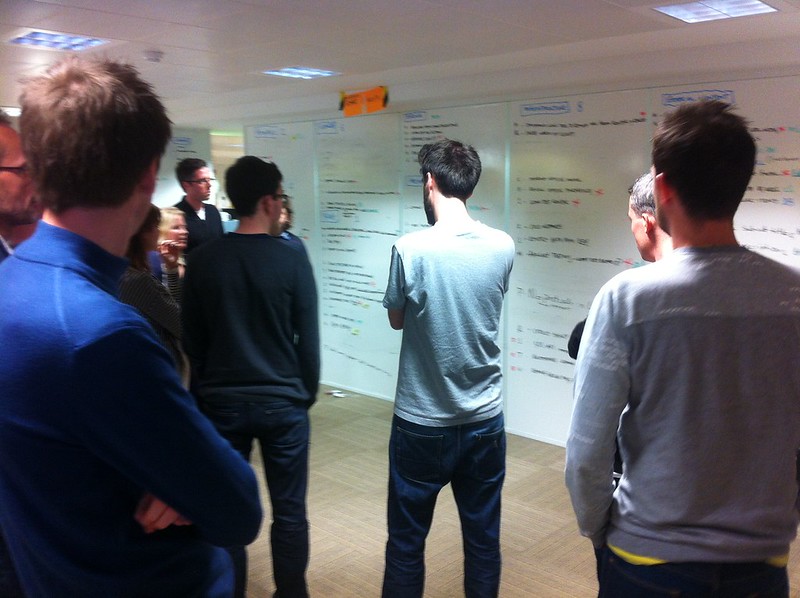Efficient Standup Meetings
2022-08-29
All modern and agile organizations have them, stand-up or daily meetings. They are a short daily sync, generally in the morning, that make sure every team member is up to speed on what everybody is doing.
The use of the stand-up is to pick up slack and make sure that certain vital information is communicated. To be honest a functional team would not need this kind of meeting, since all this info would be shared over a coffee or at the water cooler. But even the best teams make sure that the stand-up is observed, since break down in communication can be a risky and expensive situation.

"Stand up meeting" by Ben Terrett is licensed under CC BY-NC-ND 2.0 .
Pick the Right Time
It is common to schedule the meeting “first thing in the morning”, which generally results in 9AM. At the same time, many organizations have flex time, if you need to observe a meeting every day at 9AM, that does not sound very flexible to me. Even if your team is a set of early birds, even at 9AM not everybody has had enough coffee and is firing on all cylinders. Picking any time in mid morning or mid afternoon, to allow for flex time, means there is a good chance that it will create an additional interruption.
An interesting alternative can be right before the lunch break. This has two benefits, on the one hand it creates a sense of urgency to finish on time, as you want to go for lunch. On the other hand it also reduces interruptions; as you would have gone for lunch anyway and interrupted your work, now you only stop earlier.
Pick the Right Duration
Even if you communicate that you will end the meeting when you are done, meetings tend to take up the time allocated. As a rule of thumb you should not make your meeting longer than 1 minute per participant and maybe 2 minutes of slack time before and after the meeting. Each participant should be able to give their status for the last day in under a minute, if that is not the case, you have other problems.
Pick the Right People
Generally, the entire team should be present. But there is a caveat; it is common for scrum teams to consider people like the product owner part of the team. But the product owner may have a conflict of interest, they are both a team member and are responsible to the customer and other stakeholders. It is important that honest status can be freely shared and problems discussed without running the risk of someone “helping out”.
Likewise in some organizations developers and tester are not part of the same team. It can be beneficial to include testers and other people that contribute to the final goal.
Stick to the 3 Questions
The 3 questions you are answering during a stand-up is:
- What did you do since the last meeting?
- What will you do until the last meeting?
- What impediments do you have?
It is important to stick to these 3 questions and answer them in a short and terse way, just enough information for everybody to understand it. Generally you should not need more time than 1 minute to answer all 3 questions.
Defer Discussion and Details
Certainly there will be a need for discussion or more details on a subject. During stand-up it is important to not start a discussion or ask for details. If there is a need for more details, agree to meet after the stand-up or at a later point in time. This allows those team members who do not care about the information work instead of waiting time in a meeting.
Even with information that “regards everybody” it makes sense to defer it to the end of the meeting. For one keeps the dynamic of the 3 questions flowing and it is quit often the case that “everybody” does not actually mean everybody.
Use Visual Queues for Moderation

Saying people should not ramble on or defer discussion interrupts the flow of discussion; which may still be mostly legitimate. I have started using handball referee cards for moderation:
Blue Card: Please keep your answer short
This can either be shown after a specific agreed upon time limit or when the moderator feels like the person is starting to get into too much detail. It should be understood that this is a soft reminder and the person should continue and finish their elaboration.
Yellow Card: Please defer discussion
In most teams it is agreed that a question or two about calcifications or short notes on the status are ok. The yellow card should be raised when proper discussion is starting to form. It is agreed that this discussion should be done after the stand-up.
Red Card: Please stick to the 3 Questions
The red card can be used when people talk about unrelated topics or if the meeting is not coming to order. It is generally a reminder that we are now doing a stand-up meeting and all discussions about Joe’s sailing trip can be done later.
Use a Pickup
When one is done with their 3 questions, they should pass the word on to the next person. Especially in online stand-up meetings, where the order is not pertinently obvious this can remove moments of silence where it is not clear if the person is done.
If you are having an in person meeting, the order can be as simple as around the circle. In online meetings having a clear and predetermined order can be a good idea. An interesting twist on this is the random order in which the person that is currently talking nominates the next person. This forces people to remain involved in the meeting and not zone out.